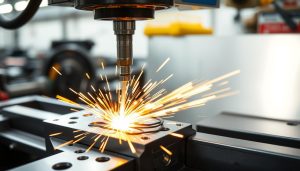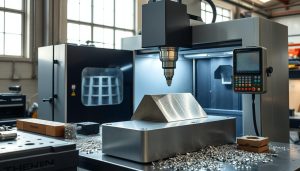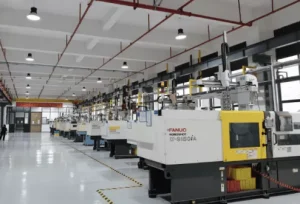In the world of metalworking, the choice between laser welding and MIG welding can have a significant impact on the success of your project. These two welding techniques offer distinct advantages and are suited for different applications. As you navigate the world of welding, it’s essential to understand the key differences between laser welding and MIG welding to determine the most appropriate method for your specific needs.
What is Laser Welding?
Laser welding is a highly precise and efficient joining technique that utilizes a concentrated beam of light to create strong, high-quality welds. Unlike traditional welding methods, the laser welding process relies on a focused energy source to melt and fuse materials together with exceptional accuracy and speed.
Overview of the Laser Welding Process
The laser welding process works by directing a narrow, high-energy laser beam onto the materials to be joined. The concentrated heat source quickly melts the surface of the workpieces, allowing them to fuse together. This laser-based approach ensures a tight, uniform weld with minimal distortion and a small heat-affected zone.
Advantages of Laser Welding: Precision and Speed
Laser welding offers several key advantages over traditional welding methods, such as high-precision welding and increased speed. The focused laser beam can create welds as narrow as 0.5 mm, allowing for precise control and the ability to work with thin materials. Additionally, the rapid heating and cooling process enables faster welding speeds, often up to 10 times faster than conventional welding techniques.
The laser welding process is particularly well-suited for applications that require tight tolerances, intricate designs, and consistent results, making it a popular choice in industries like automotive, aerospace, and electronics manufacturing.
“Laser welding is revolutionizing modern manufacturing with its unparalleled precision and efficiency.”
| Feature | Laser Welding |
|---|---|
| Weld Width | 0.5 – 2 mm |
| Welding Speed | Up to 10 times faster than conventional welding |
| Precision | Highly accurate, with minimal distortion |
| Heat-Affected Zone | Narrow, reducing the risk of material damage |
What is MIG Welding?
MIG (Metal Inert Gas) welding, also known as gas metal arc welding (GMAW), is a versatile welding technique that has become a popular choice for a wide range of industries. This welding method utilizes a continuous wire electrode that is fed through a welding gun, producing a stable and consistent arc that melts the base metal and the filler wire, creating a strong and durable weld.
Overview of the MIG Welding Process
In the MIG welding process, an electric arc is formed between a consumable wire electrode and the base metal, with a shielding gas (such as argon or carbon dioxide) protecting the weld pool from atmospheric contamination. The wire electrode is automatically fed through the welding gun, providing a consistent and continuous supply of filler material to the weld joint. This process allows for quick and efficient welding, making it a popular choice for a variety of applications.
Benefits of MIG Welding: Strength and Versatility
- Produces strong, high-quality welds that are suitable for a wide range of materials, including mild steel, stainless steel, and aluminum.
- Offers excellent control over the weld bead, resulting in consistent and uniform welds.
- Requires relatively low skill levels compared to other welding techniques, making it a popular choice for both professional and DIY applications.
- Provides high deposition rates, enabling faster welding speeds and increased productivity.
- Versatile and can be used in a variety of positions, including flat, horizontal, vertical, and overhead.
The MIG welding technique, or gas metal arc welding, is a highly versatile and efficient welding method that offers numerous benefits, including strength, consistency, and ease of use. Its wide range of applications and ability to work with a variety of materials make it a popular choice for many industries, from automotive and construction to manufacturing and fabrication.

Key Differences Between Laser Welding and MIG Welding
When it comes to welding, the choice between laser welding and MIG welding can have a significant impact on the speed, precision, and material compatibility of your project. Understanding the key differences between these two techniques is crucial for selecting the right approach for your specific needs.
Speed and Efficiency: Which Process is Faster?
Laser welding is renowned for its incredible speed and efficiency, with the ability to complete welds up to 10 times faster than traditional MIG welding. This rapid processing time can be a game-changer in high-volume production environments, where time and productivity are of the essence.
Precision and Distortion: Comparing the Results
Laser welding shines when it comes to precision, delivering a narrow, focused heat-affected zone and minimizing distortion in the final product. This makes it an excellent choice for applications where tight tolerances and intricate details are critical, such as in the aerospace and automotive industries. In contrast, MIG welding tends to produce a wider heat-affected zone, which can lead to increased distortion and warping of the materials.
Materials Compatibility: When to Use Laser or MIG Welding
The materials you’re working with can also play a significant role in determining the most suitable welding method. Laser welding excels at joining dissimilar metals, such as aluminum and steel, as well as materials with high reflectivity, like copper. MIG welding, on the other hand, is more versatile and can be used on a wider range of metals, including stainless steel, mild steel, and aluminum.
| Welding Characteristic | Laser Welding | MIG Welding |
|---|---|---|
| Speed and Efficiency | Faster, up to 10x compared to MIG | Slower, but more versatile |
| Precision and Distortion | Narrow heat-affected zone, minimal distortion | Wider heat-affected zone, increased distortion |
| Material Compatibility | Excellent for dissimilar metals, high reflectivity materials | Versatile for a wide range of metals |
By understanding the unique strengths and limitations of laser welding and MIG welding, you can make an informed decision on the best approach for your specific welding speed comparison, precision welding, and material compatibility requirements.

Cost Comparison: Laser vs MIG Welding
When it comes to choosing between laser welding and MIG welding, the cost factor plays a crucial role. Let’s explore the initial setup and equipment costs, as well as the operational efficiency and long-term cost-effectiveness of these two welding methods.
Initial Setup and Equipment Costs
Laser welding equipment typically requires a higher upfront investment compared to MIG welding. The laser system itself, along with the specialized optics and control systems, can be more expensive. However, this initial cost can be offset by the increased operational efficiency and cost-effective nature of laser welding in the long run.
Operational Costs and Efficiency
MIG welding, on the other hand, generally has lower welding equipment costs for the basic setup. But the operational costs can be higher due to the need for shielding gas, consumable wire, and potentially more labor-intensive processes. Laser welding, with its higher precision and faster welding speeds, can offer significant savings in terms of energy consumption, material waste, and overall productivity, resulting in a more cost-effective solution in the long term.
Ultimately, the decision between laser welding and MIG welding should be based on a comprehensive analysis of the project’s specific requirements, production volumes, and the long-term cost implications for your manufacturing operations.
“Investing in the right welding technology can have a profound impact on your operational efficiency and long-term profitability.”
Applications of Laser Welding vs MIG Welding
In the world of industrial welding, laser welding and MIG welding have their own unique applications, particularly in the automotive and aerospace industries. Understanding the strengths and limitations of each process can help manufacturers choose the best welding method for their specific manufacturing needs.
Automotive and Aerospace Industry Applications
Laser welding excels in applications that require precision and speed, making it an ideal choice for automotive and aerospace manufacturing. The narrow, deep weld penetration of laser welding is well-suited for joining thin metal parts, such as those found in car bodies and aircraft fuselages. Additionally, the non-contact nature of laser welding reduces the risk of distortion, ensuring a high-quality, visually appealing finish.
On the other hand, MIG welding is a versatile process that is widely used in automotive and aerospace fabrication. Its ability to handle a wide range of materials, including thicker sections, makes it a reliable choice for structural components, such as vehicle frames and engine mounts. The strength and durability of MIG welds also make it a popular option for high-stress applications.
Which Welding Method is Best for Your Manufacturing Needs?
When choosing between laser welding and MIG welding for your industrial welding applications, it’s important to consider factors such as the specific requirements of your project, the materials being joined, and the desired finish quality. Laser welding may be the better choice for high-precision, high-speed automotive welding or aerospace welding applications, while MIG welding may be more suitable for fabrication tasks that require robust, reliable welds.
Ultimately, the decision between laser welding and MIG welding should be based on a thorough evaluation of your manufacturing needs and the capabilities of each welding process. Consulting with a welding expert can help you determine the most effective solution for your industrial welding requirements.
Shixinproto tailors laser and MIG welding solutions to your needs
At Shixinproto, we understand that every welding project is unique, with its own set of requirements and challenges. That’s why we offer customized welding solutions tailored to your specific needs. Our team of welding experts is well-versed in both laser and MIG welding techniques, and we’re committed to providing professional welding services that exceed your expectations.
Whether you’re working on an automotive, aerospace, or manufacturing project, our expert welding consultation can help you determine the best welding method for your needs. We’ll take the time to understand your project’s unique requirements, from the materials you’re using to the desired finish and performance specifications. Armed with this information, we’ll guide you in selecting the most appropriate welding solution, ensuring optimal results and a seamless project execution.
At Shixinproto, we believe that successful welding projects are built on a foundation of expertise and attention to detail. That’s why we invest in the latest welding technologies and continuously train our team to stay ahead of the curve. With our customized welding solutions, you can trust that your project will be handled with the utmost care and precision, delivering the results you need to achieve your goals.





